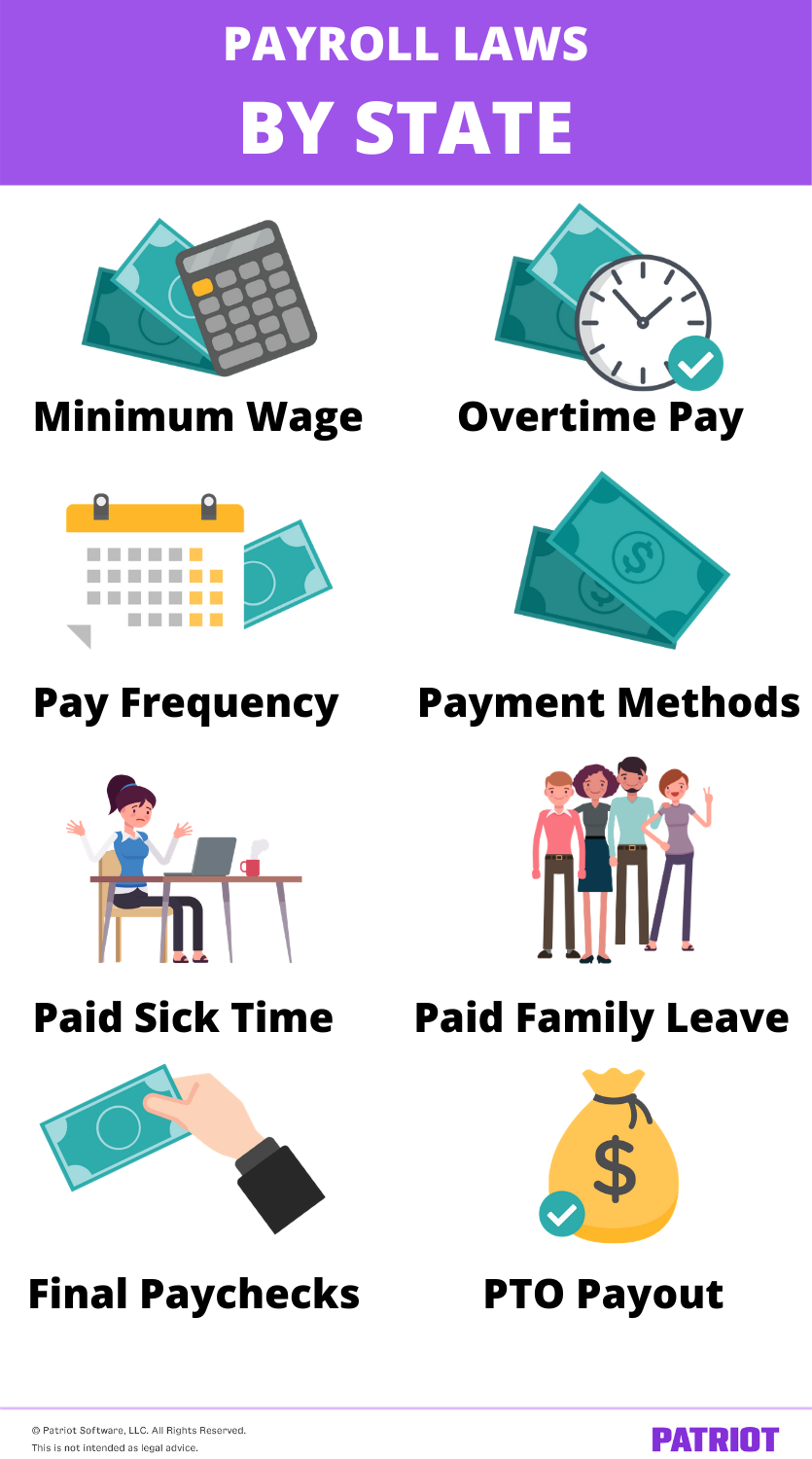When it comes to payroll regulations, there’s a lot you need to keep track of. In addition to federal laws, your state likely has its own rules in place. So, how familiar are you with payroll laws by state?
From minimum wage to mandatory paid time off, read on to learn about common payroll rules by state.
8 Common payroll laws by state
Following federal laws is critical for payroll compliance. But if you only follow federal laws and dismiss state regulations, you could wind up with substantial penalties.
Take a look at the following payroll rules by state that could impact your business.

1. Minimum wage
You’re likely familiar with minimum wage laws—you know, the minimum amount you can pay an employee per hour under federal law. The federal minimum wage is currently $7.25 per hour, but that might not be the rate you need to follow.
States can set a higher minimum wage than the federal rate. And, many do. Approximately half of the states require employers to pay employees a higher minimum wage.
If your state’s minimum wage is higher than the federal wage, you have to follow it. And, don’t forget that localities can set an even higher minimum rate that trumps state law.
One more question for you: Do you have employees who earn tips? Although the federal tipped minimum wage is $2.13 per hour, your state may set a higher tipped minimum wage, too. And if it does, you have to follow it.
Failing to pay employees your state’s regular or tipped minimum wage will no doubt upset your workers—and violate employment laws.
2. Overtime pay
Under federal law, you must pay nonexempt employees 1.5 times their regular hourly rate for any hours they work over 40 in a workweek.
But, some states take overtime pay a step further by setting daily overtime laws for nonexempt employees.
These laws require employers to pay employees the overtime rate if they work more than a certain number of hours in a day (e.g., 8, 10, or 12 hours).
In addition to overtime pay laws, California requires employers to provide double-time wages in some situations. If you’re a California employer and a nonexempt employee works more than 12 hours in a workday, provide double-time pay for the extra hours.
3. Pay frequency
Your state might also regulate how often you must pay employees. Pay frequency requirements by state determine whether you must pay employees at least weekly, biweekly, semimonthly, or monthly.
Almost every state has pay frequency requirements. Alabama, Florida, and South Carolina do not.
For example, Delaware employers must pay employees semimonthly, biweekly, or weekly. If you’re a Delaware employer, you cannot pay employees monthly.
4. Payment methods
Some states also regulate the way you pay your employees. Direct deposit and pay card laws by state may prohibit you from paying employees via direct deposit and pay cards if you don’t meet certain requirements.
For example, your state may require you to do the following before paying employees with these methods:
- Ask employees for permission
- Offer additional payment methods (e.g., paper check)
- Cover accompanying fees
- Notify employees of fees
Before setting up payroll for a new hire, check your state’s laws on acceptable payment methods.
5. Paid sick time
There is a growing number of states that require employers to provide paid sick time to employees.
State-mandated paid sick leave laws determine how many hours employees can use when they are sick. And, state laws dictate what employees can use the sick time for, where they cap out at, and whether they can carry over unused sick time from year to year.
If your state has paid sick leave laws, your payroll will be impacted. You will need to track how many days off your employees have and pay them for the time they use.
6. Paid family leave
Several states require employers to give employees paid family leave (PFL). But, employers do not pay employees for time off out of pocket.
Instead, paid family leave law requires you to withhold, contribute, or withhold and contribute money from an employee’s wages. Then, you remit it to the state, and the state distributes paid family leave benefits to qualifying employees.
If you’re impacted by this payroll law, understand how much to withhold from an employee’s wages or contribute to the PFL premium.
7. Final paychecks
The majority of states have final paycheck laws in place. These laws regulate when employers must provide an employee with their last paycheck when they leave a business. Many states have different laws depending on whether the employee quit or was fired.
Understand final paycheck laws by state to ensure you don’t miss your state’s deadline.
8. PTO payout
Whether your state requires you to offer paid time off or not, PTO payout laws by state may apply to you. Payout laws require you to pay employees for earned but unused paid time off either at the end of the year or at the time of termination.
So, do these laws affect you?
If you offer paid time off to employees and your state has a PTO payout law, you must follow it. You can figure out how much time you owe the employee by multiplying their hourly rate by the number of earned but unused hours.
Keeping up with the many payroll rules by state
Payroll laws by state are always changing. As a result, many business owners have trouble keeping up with them. Here are a few things you can do to stay up-to-date with your state’s regulations:
- Subscribe to payroll-related publications
- Touch base with your state
- Pay attention to notifications from your state
- Use online payroll software
Keeping up with changing payroll laws by state is tricky. But, it doesn’t have to be. Patriot’s payroll automatically updates to reflect current tax laws. Why not start your free trial today?
This is not intended as legal advice; for more information, please click here.


